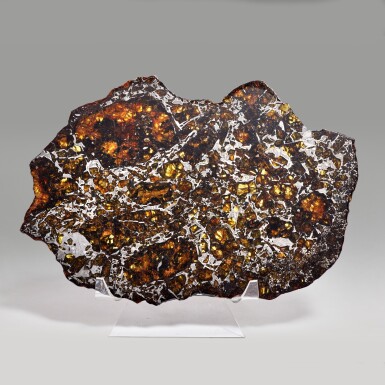Lot Description: This is a complete slice of a meteorite with extraterrestrial gemstones. Highly translucent olivine and peridot are plentiful and are fixed in a metallic matrix — formerly the molten core of an asteroid. The meteorite’s exterior rim is a semi-gloss amalgam of olivine and metal, the result of the meteorite’s frictional heating in Earth’s atmosphere following its sojourn through the solar system. Modern cutting. 141 x 89 x 2mm (5.5 x 3.5 x 0.1 in.) 147.1g (0.33 lb) A quintessential example of the most beautiful extraterrestrial substance known. The pallasite designation for this meteorite class is in honor of the German scientist, Peter Pallas, who, while travelling through Siberia, examined the first pallasitic mass in the early 1770s. This is an honor Pallas is most fortunate to have received, for he fervently believed the unusual specimen could not possibly have come from outer space. He was mistaken. This specimen, comprised of a mosaic of sparkling olivine and peridot in a gleaming nickel-iron matrix. Pallasites are widely considered the most beautiful meteorites (see lots 1, 7, 14 & 21), and Imilac is among the most coveted. Less than 0.2% of all meteorites are pallasites and, like other pallasites, Imilac originated from the mantle-core boundary of an asteroid that broke apart during the early history of our solar system. The crystals seen here are the result of small chunks of the lower regions of the stony mantle becoming suspended in molten metal near the top of the asteroid’s iron-nickel core. The meteorite from which this slice was cut was found in the Atacama Desert in the Andes, the oldest desert on Earth and one of the driest regions in the world The crystals seen here are the result of small chunks of the asteroid’s stony mantle becoming suspended in molten metal near the surface of its iron-nickel core. The lustrous metallic matrix features crystals of gleaming olivine and peridot (gem-quality olivine) ranging in hues from emerald to amber. Christie's would like to thank Dr. Alan E. Rubin at the Institute of Geophysics and Planetary Physics, University of California, Los Angeles for his assistance in preparing this catalogue. Please note this lot is the property of a private individual.
Lot Description: This is a complete slice of a meteorite with extraterrestrial gemstones. Highly translucent olivine and peridot are plentiful and are fixed in a metallic matrix — formerly the molten core of an asteroid. The meteorite’s exterior rim is a semi-gloss amalgam of olivine and metal, the result of the meteorite’s frictional heating in Earth’s atmosphere following its sojourn through the solar system. Modern cutting. 141 x 89 x 2mm (5.5 x 3.5 x 0.1 in.) 147.1g (0.33 lb) A quintessential example of the most beautiful extraterrestrial substance known. The pallasite designation for this meteorite class is in honor of the German scientist, Peter Pallas, who, while travelling through Siberia, examined the first pallasitic mass in the early 1770s. This is an honor Pallas is most fortunate to have received, for he fervently believed the unusual specimen could not possibly have come from outer space. He was mistaken. This specimen, comprised of a mosaic of sparkling olivine and peridot in a gleaming nickel-iron matrix. Pallasites are widely considered the most beautiful meteorites (see lots 1, 7, 14 & 21), and Imilac is among the most coveted. Less than 0.2% of all meteorites are pallasites and, like other pallasites, Imilac originated from the mantle-core boundary of an asteroid that broke apart during the early history of our solar system. The crystals seen here are the result of small chunks of the lower regions of the stony mantle becoming suspended in molten metal near the top of the asteroid’s iron-nickel core. The meteorite from which this slice was cut was found in the Atacama Desert in the Andes, the oldest desert on Earth and one of the driest regions in the world The crystals seen here are the result of small chunks of the asteroid’s stony mantle becoming suspended in molten metal near the surface of its iron-nickel core. The lustrous metallic matrix features crystals of gleaming olivine and peridot (gem-quality olivine) ranging in hues from emerald to amber. Christie's would like to thank Dr. Alan E. Rubin at the Institute of Geophysics and Planetary Physics, University of California, Los Angeles for his assistance in preparing this catalogue. Please note this lot is the property of a private individual.
.jpg)
.jpg?w=400?width=1600&quality=70)
.jpg)
.jpg)
.jpg)
.jpg)
.jpg)
.jpg)
.jpg)
.jpg)


.jpg)
.jpg)
.jpg)
Try LotSearch and its premium features for 7 days - without any costs!
Be notified automatically about new items in upcoming auctions.
Create an alert